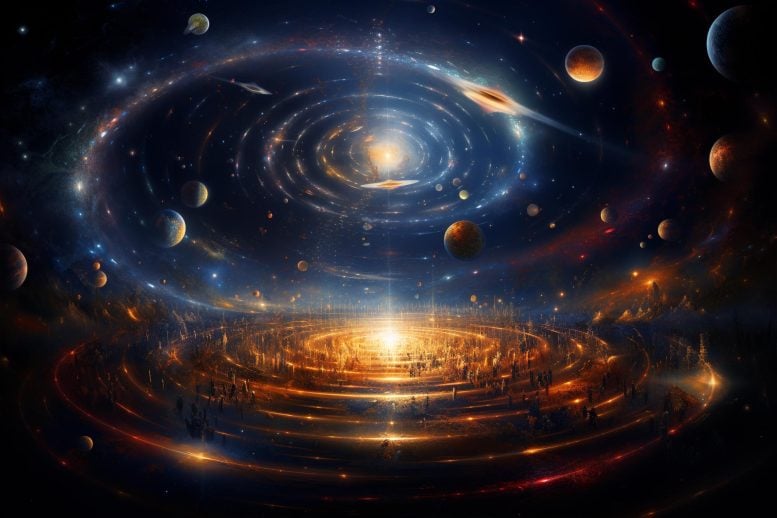
A new study suggests the universe might be 26.7 billion years old, almost double the widely accepted age of 13.7 billion years. The new model, incorporating Zwicky’s tired light theory and Dirac’s evolving coupling constants, could explain the existence of mature, small galaxies formed just 300 million years post-Big Bang and propose a revised interpretation of the cosmological constant.
A new study proposes that the universe may be 26.7 billion years old, challenging the widely accepted estimate of 13.7 billion years based on the Lambda-CDM concordance model.
Our universe could be twice as old as current estimates, according to a new study that challenges the dominant cosmological model and sheds new light on the so-called “impossible early galaxy problem.”
“Our newly-devised model stretches the galaxy formation time by several billion years, making the universe 26.7 billion years old, and not 13.7 as previously estimated,” says author Rajendra Gupta, adjunct professor of physics in the Faculty of Science at the University of Ottawa.

“Our newly-devised model stretches the galaxy formation time by a several billion years, making the universe 26.7 billion years old, and not 13.7 as previously estimated”. Rajendra Gupta — Adjunct professor of physics in the Faculty of Science at the University of Ottawa. Credit: University of Ottawa
For years, astronomers and physicists have calculated the age of our universe by measuring the time elapsed since the Big Bang and by studying the oldest stars based on the redshift of light coming from distant galaxies. In 2021, thanks to new techniques and advances in technology, the age of our universe was thus estimated at 13.797 billion years using the Lambda-CDM concordance model.
The Lambda-CDM (Lambda-Cold Dark Matter) concordance model, also known as the standard model of cosmology, is currently the simplest and most widely accepted model that describes the evolution of the universe from its earliest moments to the present day.
However, many scientists have been puzzled by the existence of stars like the Methuselah that appear to be older than the estimated age of our universe and by the discovery of early galaxies in an advanced state of evolution made possible by the James Webb Space Telescope. These galaxies, existing a mere 300 million years or so after the Big Bang, appear to have a level of maturity and mass typically associated with billions of years of cosmic evolution. Furthermore, they’re surprisingly small in size, adding another layer of mystery to the equation.
Zwicky’s tired light theory proposes that the redshift of light from distant galaxies is due to the gradual loss of energy by photons over vast cosmic distances. However, it was seen to conflict with observations. Yet Gupta found that “by allowing this theory to coexist with the expanding universe, it becomes possible to reinterpret the redshift as a hybrid phenomenon, rather than purely due to expansion.”
“Our newly-devised model stretches the galaxy formation time by several billion years, making the universe 26.7 billion years old, and not 13.7 as previously estimated.”
— Rajendra Gupta, Adjunct professor of physics in the Faculty of Science at the University of Ottawa
In addition to Zwicky’s tired light theory, Gupta introduces the idea of evolving “coupling constants,” as hypothesized by Paul Dirac. Coupling constants are fundamental physical constants that govern the interactions between particles. According to Dirac, these constants might have varied over time. By allowing them to evolve, the timeframe for the formation of early galaxies observed by the Webb telescope at high redshifts can be extended from a few hundred million years to several billion years. This provides a more feasible explanation for the advanced level of development and mass observed in these ancient galaxies.
Moreover, Gupta suggests that the traditional interpretation of the “cosmological constant,” which represents dark energy responsible for the accelerating expansion of the universe, needs revision. Instead, he proposes a constant that accounts for the evolution of the coupling constants. This modification in the cosmological model helps address the puzzle of small galaxy sizes observed in the early universe, allowing for more accurate observations.
On July 7, 2023, the study, “JWST early Universe observations and 𝚲CDM cosmology,” was published in the Monthly Notices of the Royal Astronomical Society (MNRAS) by Oxford University Press.
Reference: “JWST early Universe observations and ΛCDM cosmology” by R Gupta, 7 July 2023, Monthly Notices of the Royal Astronomical Society.
DOI: 10.1093/mnras/stad2032

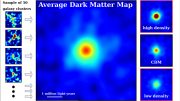

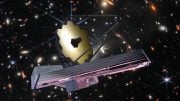
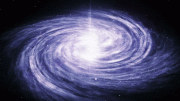
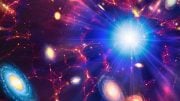
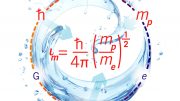
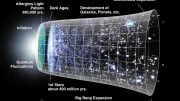
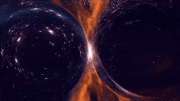
“Tired light”? Does that mean that photons from great distances away are traveling at a slower rate than the speed of light?
According to this article, “tired” light loses energy. Since energy is directly proportional to frequency, this light’s frequency decreases, that is it becomes redder.
All electromagnetic waves (light) travel at the same speed through vacuum regardless of frequency.
Man will never understand the universe we can only make observations about it and we will never know the truth about it ,it is GODS AND GODS ALONE man would like to think he knows but he will never know ,only dream of knowing
We said the same thing about lightning. And so we invented a God for it. Now that God is forgotten.
Assigning God to things we don’t understand at this moment is just a renaming of our ignorance. Asked to solve for X, you are saying God = X. You add nothing new.
Who made the god?
We have understood the universe since 2016, when the Planck observations put LCDM on form footing. LCDM explains the space expansion process that makes the universe.
LCDM also handily rejects magic superstitions, such as your comment unnecessarily alludes to, since the entire universe develops in an entirely natural process. There is no longer room for magic of any kind.
Typo. “form footing” = firm footing.
Gary, as you appear to already have your answer to the mystery of the universe, perhaps you should concentrate on the study of theology? Especially if your only response to new research into the present understanding of the universe is a god did it!
Armed with these educated guesses, how many miles of crumbling miles of potholes could have been repaired, how many starving children could have been fed or how much universal healthcare could have paid the best doctors to care for all the people, not just the rich?
We are better off now than we were 100, 1000, 10000 years ago. We live longer, and we now have more roads, so that we may have more potholes in them.
Almost all of our advances came from science. Such advancements need investments. Being shortsighted is not the way to progress.
As for money, far less money is spent on science than on other types of bs. How many trillions have been spent on shoring up banks, just in the US, and just in the last couple of decades? Aside from politically motivated obfuscation, it isn’t hard to reason why allowing banks to freely speculate with publicly insured money would lead to losses to taxpayers. There’s more than enough money to feed everyone, and to fix potholes. But that money isn’t being “wasted” on science.
I’ll disagree with your POIV. With a limited amount of scientific research money, how that money is deployed should be a critical question.
Whatever happened 13 billion years ago in the first 10 seconds of the creation of our reality generates no real modern day gain. Such monies should be redirected to more potentially useful research.
My point is that there are other savings to be had.
When trying to save money, it is better to target the $1000 frivolous purchase than the $1 frivolous purchase.
Also, your assertion that learning about the early universe is useless, is unproven. People said the same thing about electricity. Early universe physics is unknown, and knowing that can be useful.
The newly developed detectors of astronomical observatories such as the Webb telescope that the work bases its supposed problems on has routinely been used to save life and health in hospital equipment after. This is is the very definition of societal useful research (besides answering our insatiable curiosity)!
If (I suspect not) we can use science to predict exactly what science results will go into useful technology we can have a discussion on priorities. Who new that researching semiconductor physics would lead to a technology that allows people to cooperate across the globe without massive airplane greenhouse emissions!?
Meanwhile, the investment on science – which gives among the best Return-On-Investment we know – is marginal compared to the money that goes into roads. The amount of starving people was in the latest estimate 54 million then (old estimate), a 0.7 % of 8 billions and far less than those afflicted by malaria – which we can beat with science. And that US has no universal healthcare – as many other nations have – is likely not caused by medical science but its politically caused absence.
Typo: “Who new” = Who knew.
This is a brilliant new view of some fundamental cosmological assumptions. Given that they are largely assumptions, this new formulation seems quite reasonable, and results in a more elegant model of the universe. Presumably, as the Dirac coupling constants interact, energy must be transferred from the EM field, translating EM frequency into some other form of excitation, or excitation in some other field. Dirac also asserted that the more beautiful an expression describing nature might be, the more likely it is to be true. Creation is not only miraculous, it’s exquisitely beautiful, all the more so as we come to understand it better.
Tired light is considered unreasonable. And if it doesn’t respond to all its problems, which the abstract implies, that is also unreasonable.
But on a general note, a hypothesis that suggests any number of free parameters can explain “anything” and so has no explanatory power. (C.f. religion for a similar non-empirical notion of ‘explanation’.) The more free parameters you give a theory, the weaker it is and if in excess such weakening can be considered unreasonable.
So instead of admitting they got Red Shift assumptions wrong (and the nonsensical Dark Matter and Dark Energy that followed to “fix the math”), now we’re just doubling the age of the Universe to explain why things that shouldn’t exist with a Big Bang and expanding universe based on Dark Energy and Dark Matter are being observed to exist in spades. Perhaps the Universe isn’t expanding at all and recycles itself via black holes endlessly.
Our ignorance is based on pure assumptions that Webb is plainly making clear were wrong in the first place, but the establishment (like forbidden archeology) doesn’t want to admit they may have made fundamental mistakes. Ego is at stake so we keep making up more things to force square pegs to fit into round holes.
It’s not only ego at stake. Careers, reputation, status and the ability to gain speaking/book sales are also tied in.
‘It is difficult to get a man to understand something, when his salary depends on his not understanding it.”
— Upton Sinclair
@Joso: And you are even worse than Captain Jack, if possible, because you indulge in conspiracy ideation [!]. The only sane response is laughs – lots of LOLs.
Redshift is an observation, not an assumption.
And LCDM is a well tested theory – so not an assumption either – that is not threatened by current observations or this fringe work. It predict what we see and you do not, so your ideas are not even fringe. If you have no predictions, you have nothing but your personal opinion fantasy, while the rest of us has the facts of nature.
Zwicky’s tired light theory was known by Zwicky himself to be impossible by observations due to various problems. Wikipedia:
“The concept was first proposed in 1929 by Fritz Zwicky, who “suggested that if photons lost energy over time through collisions with other particles in a regular way, the more distant objects would appear redder than more nearby ones. Zwicky himself acknowledged that any sort of scattering of light would blur the images of distant objects more than what is seen. Additionally, the surface brightness of galaxies evolving with time, time dilation of cosmological sources, and a thermal spectrum of the cosmic microwave background have been observed—these effects should not be present if the cosmological redshift was due to any tired light scattering mechanism. Despite periodic re-examination of the concept, tired light has not been supported by observational tests and remains a fringe topic in astrophysics.”
Since the paper is paywalled it is impossible for readers to see if all these problems have been solved. From the abstract it is claimed that the work solves the isotropy of the cosmic microwave background and the supernovae – but maybe not galaxy – brightness (distance modulus) time evolution problem. There is a recent high-z (large distance) time dilation measurement that fits LCDM well, and there remains the primary blurring problem that the work may not have solved.
As for the star age and JWST observations that the work attempts to explain, JWST observations are currently not a sufficiently dire problem for LCDM but has implications for early structure formation models, and the star age estimates overlap with LCDM age estimates.
So this is fringe or possibly conflicting with observations.
How convoluted can the logic become? Let’s stick with Occam’s Razor and admit that we don’t know the age of the Universe and that these conflicted observations mean that there’s much more to learn…